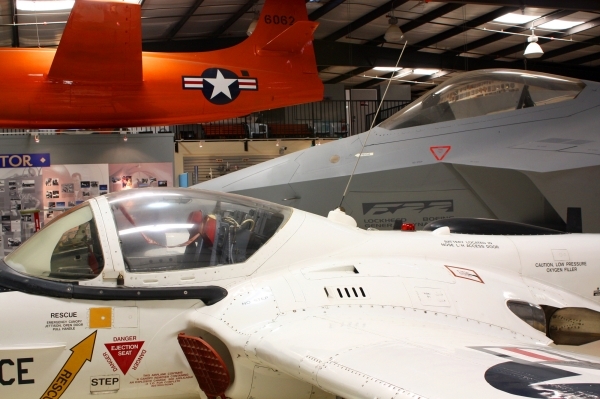|
|
| 
 |
|
Below are a few of the exhibits located at the Air Force Flight Test Museum on Edwards AFB.
F-22 Fighter Jet

The supersonic gray jet fighter in the middle of this photo is the very first F-22 jet fighter Ė actually the first of two YF-22A prototypes. It is the centerpiece display inside the Air Force Flight Test Museum. The YF-22 flight program was conducted here at Edwards Air Force Base. Considered the air dominance fighter of the 21st Century, the production-variant F-22 owes its existence to the successful flight demonstration program of this YF-22A prototype and a second YF-22A that ensured selection of this aircraft over its YF-23 rival for production. The museumís YF-22A showcased airworthiness, supersonic flight, and systems performance. This jet performed aerial refueling tests which proved the YF-22ís ability to take on fuel from a tanker aircraft. This had the added advantage during the brief flight program of the YF-22s to enable this prototype to remain aloft for longer periods of productive test time. The pair of YF-22s logged a total of 92 hours of flying time between 29 September 1990 and the conclusion of the program about three months later. First-flight pilot Dave Ferguson brought the museumís YF-22A from nearby Palmdale, California, to Edwards during a rare thunderstorm. The wet-runway environment provided an additional test point successfully accomplished on that initial flight. A team of F-22 maintenance specialists from the 31st Test and Evaluation Squadron and the 412th Aircraft Maintenance Squadron dismantled the YF-22 at its previous site at Wright-Patterson Air Force Base, Ohio, and reassembled the rare prototype jet and readied it for display in the AFFT Museum at Edwards in 2010.
The First Flights Wall

Many of the historic aircraft that have made their first flights at Edwards AFB for more than six decades are depicted in 1/72 scale in this fascinating museum timeline.
X-1 and X-25

This is a full-size replica of the orange X-1, first aircraft to exceed the speed of sound, perches high in the AFFT Museum along with the lightweight X-25B in the foreground.
AQM-34J Firebee

This reconnaissance AQM-34J drone evolved from the Ryan Firebee target drone. It came to the AFFT Museum in 1989. The AQM-34 Firebee is a target drone and remotely piloted vehicle (RPV). It was first flown in 1951 as the Q-2 and was used as a high subsonic speed target drone. It was also used in Vietnam as a reconnaissance role and also used in the Persian Gulf War as decoys to confuse Iraq radar systems.
YA-10B

Only one experimental two-seat YA-10B was built; production A-10s are all single-seaters. The YA-10B is prominently displayed at the Air Force Flight Test Museum on Edwards Air Force Base.
SH-34G Seabat

The Sikorsky H-34 helicopter uses a Wright R1820 engine, similar to those in the World War II B-17 Flying Fortress bomber. The AFFT Museums example is an SH-34G, designated Seabat.
CT-39 Sabreliner

The North American Aviation T-39 Sabreliner served the Air Force as a light transport as well as a photo chase aircraft at the Edwards AFB.
SR-71A Blackbird

Visitors to the Air Force Flight Test Museum on Edwards AFB can view this Lockheed SR-71 Blackbird, a Mach 3 reconnaissance aircraft.
YF-100A Super Sabre

The North American YF-100A became the world's first fighter aircraft to reach supersonic speed in level flight, on its maiden flight on May 25, 1953. This aircraft is part of the Museums collection and is located at the Edwards AFB West Gate.
Norden Bombsight

The famed Norden bombsight of World War II fame is thecenter of a new display in the Air Force Flight Test Museum at Edwards AFB, California. Viewed from one side, the display describes testing and training with the Norden at Muroc (now Edwards AFB). From the opposite side of the display, the use of Norden bombsights in combat by the 95th Bomb Group is highlighted. Visitors to the display will learn answers to questions including, Who were the last users of Norden bombsights in combat conditions? How were the ultra-fine crosshairs for the bombsight made? What does the profile of a World War II high-altitude bomb drop look like, as the bomber and the bomb continue moving forward, with the bomb's forward speed diminishing during its plunge earthward?
 |
|









